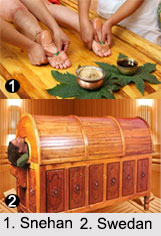 Purva Karma refers to the preparation of body for Panchakarma therapy. It helps to mobilize and liquefy waste products from the tissues and to move it out towards the intestines, which then allows the Panchakarma treatments to flush them out. This is necessary for the body to achieve the complete benefits of Panchakarma.
Purva Karma refers to the preparation of body for Panchakarma therapy. It helps to mobilize and liquefy waste products from the tissues and to move it out towards the intestines, which then allows the Panchakarma treatments to flush them out. This is necessary for the body to achieve the complete benefits of Panchakarma.
Panchakarma is an extensive treatment process of Ayurveda that eliminates toxins and restores the body"s health. This method cleanses the body, and also augments digestive and metabolic abilities. Panchakarma includes three broad sub-categories namely;
i. Purva Karma (preparatory procedures),
ii. Pradhan Karma (main procedures) and
iii. Paschat Karma (follow up treatments).
Methods of Purva Karma in Panchakarma
Before the actual operation of purification begins, there is a need to prepare the body in prescribed methods to encourage the body to let go of the toxins. The two procedures are Snehana and Swedana.
 Snehana: Snehana (Oleation) makes the body soft and disintegrates the toxins. Snehan can be of two types, internal snehan and external snehan. In internal snehan, Siddha ghrita (medicated clarified butter) or Siddha Taila (medicated edible oil) is administered orally in accordance with the dose prescribed by the Ayurvedic therapist. This ghee (ghrita) or oil is known as sneha. Acting as a lubricant to the entire body, it helps in reducing dryness. This applied oil finds entry into the dhatu (body tissues) and strotasa (body passages) and eventually purges out the impurities. The applied ghee if prepared from cow milk works best. In external snehan, there are all kinds of body massages with the help of sneha, as instructed by the Ayurvedic physician. Siddha ghrita or Siddha Taila is massaged on the skin. A strict program of body massage according to the need of the patient is carried out to attain the desired level of snehan. A lustrous skin marks external snehan. This type of snehan is beneficial for skin problems or when the patient is in bed ridden condition for a long time.
Snehana: Snehana (Oleation) makes the body soft and disintegrates the toxins. Snehan can be of two types, internal snehan and external snehan. In internal snehan, Siddha ghrita (medicated clarified butter) or Siddha Taila (medicated edible oil) is administered orally in accordance with the dose prescribed by the Ayurvedic therapist. This ghee (ghrita) or oil is known as sneha. Acting as a lubricant to the entire body, it helps in reducing dryness. This applied oil finds entry into the dhatu (body tissues) and strotasa (body passages) and eventually purges out the impurities. The applied ghee if prepared from cow milk works best. In external snehan, there are all kinds of body massages with the help of sneha, as instructed by the Ayurvedic physician. Siddha ghrita or Siddha Taila is massaged on the skin. A strict program of body massage according to the need of the patient is carried out to attain the desired level of snehan. A lustrous skin marks external snehan. This type of snehan is beneficial for skin problems or when the patient is in bed ridden condition for a long time.
Swedana: Swedana (fomentation / sweating) removes the toxins from the body by melting them. Swedana follows snehan, which implies dry or wet fomentation or heat therapy. There can be different types of fomentation procedures according to the need and body category of the patient. These are taking a sunbath, sitting in a bathtub, taking a steam bath, pouring hot water on the body or sitting in a specially prepared wooden sweatbox. Swedana can be applied to the whole body, for the diseased part of the body, or the perineal region as per the need of the patient. Many kinds of warm poultices like cloth, sand bags, heat pads and liquids like warm water, water with milk, herbal potions and medicated oil can be used for fomentation. But every procedure should be carried out under the supervision of an Ayurvedic specialist.
Thus, the procedures of Purva Karma collectively help in the purgation of the deposited toxin, the settling of the imbalanced doshas, the opening of the clogged body channels and in lubricating the passages of excretion. In fact, Purva Karma is vital because it prepares the body for Pradhan Karma, another necessary step under the process of Panchakarma.





